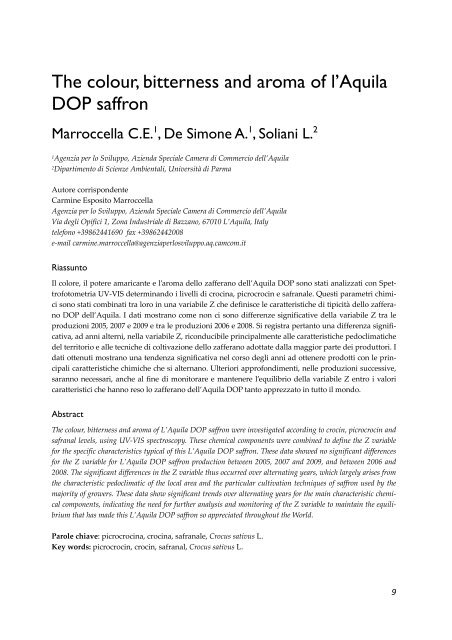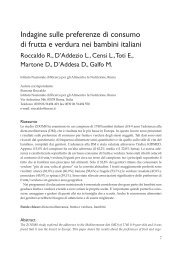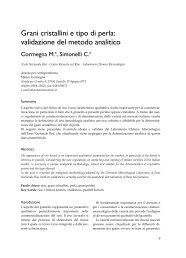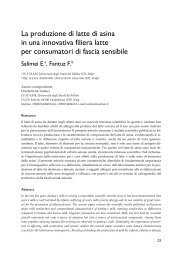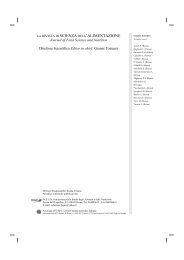The colour, bitterness and aroma of l'Aquila DOP saffron - FOSAN
The colour, bitterness and aroma of l'Aquila DOP saffron - FOSAN
The colour, bitterness and aroma of l'Aquila DOP saffron - FOSAN
You also want an ePaper? Increase the reach of your titles
YUMPU automatically turns print PDFs into web optimized ePapers that Google loves.
<strong>The</strong> <strong>colour</strong>, <strong>bitterness</strong> <strong>and</strong> <strong>aroma</strong> <strong>of</strong> l’Aquila<br />
<strong>DOP</strong> <strong>saffron</strong><br />
Marroccella C.E. 1 , De Simone A. 1 , Soliani L. 2<br />
1Agenzia per lo Sviluppo, Azienda Speciale Camera di Commercio dell’Aquila<br />
2Dipartimento di Scienze Ambientali, Università di Parma<br />
Autore corrispondente<br />
Carmine Esposito Marroccella<br />
Agenzia per lo Sviluppo, Azienda Speciale Camera di Commercio dell’Aquila<br />
Via degli Opifici 1, Zona Industriale di Bazzano, 67010 L’Aquila, Italy<br />
telefono +39862441690 fax +39862442008<br />
e-mail carmine.marroccella@agenziaperlosviluppo.aq.camcom.it<br />
Riassunto<br />
Il colore, il potere amaricante e l’<strong>aroma</strong> dello zafferano dell’Aquila <strong>DOP</strong> sono stati analizzati con Spettr<strong>of</strong>otometria<br />
UV-VIS determin<strong>and</strong>o i livelli di crocina, picrocrocin e safranale. Questi parametri chimici<br />
sono stati combinati tra loro in una variabile Z che definisce le caratteristiche di tipicità dello zafferano<br />
<strong>DOP</strong> dell’Aquila. I dati mostrano come non ci sono differenze significative della variabile Z tra le<br />
produzioni 2005, 2007 e 2009 e tra le produzioni 2006 e 2008. Si registra pertanto una differenza significativa,<br />
ad anni alterni, nella variabile Z, riconducibile principalmente alle caratteristiche pedoclimatiche<br />
del territorio e alle tecniche di coltivazione dello zafferano adottate dalla maggior parte dei produttori. I<br />
dati ottenuti mostrano una tendenza significativa nel corso degli anni ad ottenere prodotti con le principali<br />
caratteristiche chimiche che si alternano. Ulteriori appr<strong>of</strong>ondimenti, nelle produzioni successive,<br />
saranno necessari, anche al fine di monitorare e mantenere l’equilibrio della variabile Z entro i valori<br />
caratteristici che hanno reso lo zafferano dell’Aquila <strong>DOP</strong> tanto apprezzato in tutto il mondo.<br />
Abstract<br />
<strong>The</strong> <strong>colour</strong>, <strong>bitterness</strong> <strong>and</strong> <strong>aroma</strong> <strong>of</strong> L’Aquila <strong>DOP</strong> <strong>saffron</strong> were investigated according to crocin, picrocrocin <strong>and</strong><br />
safranal levels, using UV-VIS spectroscopy. <strong>The</strong>se chemical components were combined to define the Z variable<br />
for the specific characteristics typical <strong>of</strong> this L’Aquila <strong>DOP</strong> <strong>saffron</strong>. <strong>The</strong>se data showed no significant differences<br />
for the Z variable for L’Aquila <strong>DOP</strong> <strong>saffron</strong> production between 2005, 2007 <strong>and</strong> 2009, <strong>and</strong> between 2006 <strong>and</strong><br />
2008. <strong>The</strong> significant differences in the Z variable thus occurred over alternating years, which largely arises from<br />
the characteristic pedoclimatic <strong>of</strong> the local area <strong>and</strong> the particular cultivation techniques <strong>of</strong> <strong>saffron</strong> used by the<br />
majority <strong>of</strong> growers. <strong>The</strong>se data show significant trends over alternating years for the main characteristic chemical<br />
components, indicating the need for further analysis <strong>and</strong> monitoring <strong>of</strong> the Z variable to maintain the equilibrium<br />
that has made this L’Aquila <strong>DOP</strong> <strong>saffron</strong> so appreciated throughout the World.<br />
Parole chiave: picrocrocina, crocina, safranale, Crocus sativus L.<br />
Key words: picrocrocin, crocin, safranal, Crocus sativus L.<br />
9
Practical applications<br />
10<br />
LA RIVISTA DI SCIENZA DELL’ALIMENTAZIONE, NUMERO 4, OTTOBRE - DICEMBRE 2010, ANNO 39<br />
It is important for producers <strong>and</strong> users <strong>of</strong> L’Aquila<br />
<strong>DOP</strong> <strong>saffron</strong> that the equilibrium between<br />
<strong>colour</strong>, <strong>bitterness</strong> <strong>and</strong> <strong>aroma</strong> that has made this<br />
<strong>saffron</strong> so appreciated throughout the world is<br />
maintained. With the ancient traditions for its<br />
production passed down from father to son, the<br />
<strong>saffron</strong> growers need to continue to follow these<br />
processing technologies. To be sure <strong>of</strong> this, there<br />
is the need to define <strong>and</strong> monitor the specific<br />
characteristics that are typical <strong>of</strong> the L’Aquila<br />
<strong>DOP</strong> <strong>saffron</strong>. <strong>The</strong> present study provides such a<br />
monitoring process. Here, the combination <strong>of</strong> the<br />
<strong>colour</strong>, <strong>bitterness</strong> <strong>and</strong> <strong>aroma</strong> characteristics (the<br />
Z variable) <strong>of</strong> L’Aquila <strong>DOP</strong> <strong>saffron</strong> over the fiveyear<br />
period from 2005 to 2009 are shown to vary<br />
according to climate <strong>and</strong> growing conditions, indicating<br />
that the ancient processing technologies<br />
<strong>of</strong> this L’Aquila <strong>DOP</strong> <strong>saffron</strong> are indeed being<br />
respected. Similar future monitoring are needed<br />
to confirm that this situation is maintained.<br />
Introduction<br />
<strong>The</strong> <strong>saffron</strong> from L’Aquila (Abruzzo, Italy) is<br />
recognised as a protected designation <strong>of</strong> origin<br />
(<strong>DOP</strong>) according to EU Regulation N° 2081 <strong>of</strong><br />
2001 (Government Decree, 2003). <strong>The</strong> zone that<br />
comprises the thirteen boroughs <strong>of</strong> the L’Aquila<br />
province has been <strong>of</strong>ficially recognised as the<br />
protected production area. This zone is located at<br />
an altitude <strong>of</strong> between 350 m <strong>and</strong> 1,000 m above<br />
sea level, <strong>and</strong> it extends over two plateaus: Navelli<br />
<strong>and</strong> Prada d´Ansidonia.<br />
<strong>The</strong> <strong>saffron</strong> produced in this area <strong>of</strong> L’Aquila<br />
is obtained from the dried stigma <strong>of</strong> the Crocus<br />
sativus L. plant, a cultivated species <strong>of</strong> crocus that<br />
belongs to the Iridaceae family. <strong>The</strong> C. sativus<br />
from which this <strong>saffron</strong> <strong>DOP</strong> is obtained is cultivated<br />
as follows: the cultivated soil (rotated<br />
every 5 years) is prepared by ploughing to a<br />
depth <strong>of</strong> 30 cm <strong>and</strong> applying organic fertilisers;<br />
the flower-beds are laid in furrows that are 2 cm<br />
to 4 cm deep <strong>and</strong> set from 20 cm to 25 cm apart;<br />
the planted bulbs are picked in mid-August, with<br />
the collection <strong>of</strong> the flowers <strong>and</strong> the successive<br />
processes carried out by h<strong>and</strong>; preservation <strong>of</strong><br />
the finished product is obtained by drying over<br />
almond, olive or oak charcoal using a sieve, for a<br />
time that varies according to the depth <strong>of</strong> the<br />
layer <strong>of</strong> <strong>saffron</strong>. <strong>The</strong> drying phase during which<br />
the fragrant element <strong>of</strong> the <strong>saffron</strong>, safranal, develops<br />
is essential (Tammaro <strong>and</strong> Di Francesco,<br />
1978; Massimini, 1980; Piccioli, 1932).<br />
<strong>The</strong> main components <strong>of</strong> <strong>saffron</strong> are crocin,<br />
which is responsible for the characteristic <strong>colour</strong>,<br />
the glucoside picrocrocin, <strong>and</strong> safranal. Crocin is<br />
the digentiobiose ester <strong>of</strong> the carotenoid crocetin:<br />
the trans-crocetin di-(β-D-gentiobiosyl) ester.<br />
Crocetin itself is a conjugated polyene dicarboxylic<br />
acid that is hydrophobic, <strong>and</strong> thus oil soluble.<br />
Picrocrocin is responsible for the <strong>saffron</strong><br />
<strong>aroma</strong>, <strong>and</strong> from this the safranal component is<br />
derived. Safranal is the principal component <strong>of</strong><br />
the essential oil, with its characteristic scent, <strong>and</strong><br />
thus represents the odour aspect. Safranal is only<br />
formed from the picrocrocin at a late stage during<br />
the toasting <strong>and</strong> storage <strong>of</strong> the finished product.<br />
<strong>The</strong> heat, combined with enzymatic action,<br />
splits picrocrocin to yield D-glucose <strong>and</strong> a free<br />
safranal molecule (Amelotti <strong>and</strong> Mannino, 1977;<br />
Corradi <strong>and</strong> Micheli, 1979a, b; ISO3632 (1), 2003;<br />
ISO3632 (2), 2003).<br />
With the aim <strong>of</strong> characterising the L’Aquila<br />
<strong>DOP</strong> <strong>saffron</strong>, we carried out an investigation into<br />
these chemical components. This will also allow<br />
better differentiate <strong>of</strong> this L’Aquila <strong>DOP</strong><br />
<strong>saffron</strong> from <strong>saffron</strong> produced in other areas<br />
across Italy <strong>and</strong> abroad, with particular regard<br />
to its <strong>aroma</strong>, as its most distinctive <strong>and</strong> recognised<br />
characteristic.<br />
Materials <strong>and</strong> Methods<br />
Samples<br />
Two hundred <strong>and</strong> thirteen <strong>saffron</strong> samples from<br />
the Navelli <strong>and</strong> Prata D’Ansidonia plateaus were<br />
obtained in the period from 2005-2009. <strong>The</strong> analyses<br />
for the chemicals crocin, picrocrocin <strong>and</strong> safranal<br />
was carried out according to Corradi et al.<br />
1979b, <strong>and</strong> performed according to the schemes<br />
suggested by UNI CEI EN ISO/IEC 17025:2005.
C.E. Marroccella, A. De Simone, L. Soliani <strong>The</strong> <strong>colour</strong>, <strong>bitterness</strong> <strong>and</strong> <strong>aroma</strong> <strong>of</strong> l’Aquila <strong>DOP</strong> <strong>saffron</strong><br />
Colour <strong>and</strong> <strong>bitterness</strong><br />
<strong>The</strong> analyses <strong>of</strong> the crocin <strong>and</strong> picrocrocin that<br />
are responsible for the <strong>colour</strong> <strong>and</strong> bitter taste <strong>of</strong><br />
<strong>saffron</strong> were performed using spectroscopy absorbance<br />
measurements <strong>of</strong> aqueous extracted<br />
samples, each prepared from the <strong>saffron</strong> samples<br />
as follows: following crushing <strong>and</strong> sieving, 0.10 g<br />
powered <strong>saffron</strong> was weighed <strong>and</strong> transferred<br />
into a 250 mL conical flask with an emery stopper.<br />
To this was added 200 mL distilled water,<br />
<strong>and</strong> the sample was left in the dark at room temperature<br />
for 3 h, with occasional mixing. <strong>The</strong><br />
sample was then filtered through a cellulose acetate<br />
membrane (0.45 μm), <strong>and</strong> 80 mL distilled water<br />
was added to 20 mL <strong>of</strong> this filtered solution.<br />
<strong>The</strong> UV-VIS scans (210-550 nm) <strong>of</strong> these final<br />
samples were carried out in a 1-cm path-length<br />
UV cell, using distilled water as the blank. Absorbance<br />
readings were at the wavelengths <strong>of</strong> 257<br />
nm, 297 nm <strong>and</strong> 440 nm. <strong>The</strong> data were expressed<br />
as arbitrary units (a.u.), calculated according<br />
to the following:<br />
E440 10/000 : extinction <strong>of</strong> the water extract 1-10,000.<br />
Crocin levels: E440 10/000 × 7.305.<br />
ΔEpic: E257 10/000 - E297 10/000 .<br />
Aroma<br />
Safranal is responsible for the fragrance <strong>of</strong> <strong>saffron</strong>,<br />
<strong>and</strong> it was determined by spectroscopic absorbance<br />
<strong>of</strong> sample distillates, each prepared as<br />
follows: following crushing <strong>and</strong> sieving, 0.10 g<br />
powered <strong>saffron</strong> was weighed into a glass pot,<br />
<strong>and</strong> 20 mL 3% (w/v) barium hydroxide in distilled<br />
water was added. <strong>The</strong> sample was distilled by<br />
steam stripping, until 200 mL distillate was collected.<br />
UV analysis was carried out with the extinction<br />
reading at 318 nm (E318). As for crocin,<br />
the safranal levels were determined as a.u., according<br />
to: E318 × 4.<br />
<strong>The</strong> Z variable<br />
<strong>The</strong> Z variable was calculated using the relationship<br />
between the <strong>colour</strong> element, as crocin (extinction<br />
reading at 440 nm; E440; a.u.) <strong>and</strong> the sum<br />
<strong>of</strong> the <strong>aroma</strong>tic <strong>and</strong> <strong>bitterness</strong> components, as picrocrocin<br />
(calculated as E257-E297; ΔEpic; a.u.) <strong>and</strong><br />
safranal (extinction reading at 318 nm; E318; a.u.),<br />
i.e. Z (a.u.) = E440/(ΔEpic+E318).<br />
Statistical analysis<br />
<strong>The</strong> results obtained were analysed using the<br />
SPSS programme for Windows s<strong>of</strong>tware (version<br />
15.0, 2006).<br />
Results <strong>and</strong> Discussion<br />
<strong>The</strong> aim <strong>of</strong> the present study was to determine<br />
the chemical characteristics <strong>of</strong> a series <strong>of</strong> L’Aquila<br />
<strong>DOP</strong> <strong>saffron</strong> samples collected from 2005-2009, in<br />
terms <strong>of</strong> the principal components <strong>of</strong> crocin, picrocrocin<br />
<strong>and</strong> safranal.<br />
Here we used the Z variable to express the<br />
equilibrium that includes all <strong>of</strong> these chemical<br />
components that together define the specific characteristics<br />
<strong>of</strong> the <strong>colour</strong>, <strong>bitterness</strong> <strong>and</strong> <strong>aroma</strong>,<br />
respectively, that are typical <strong>of</strong> L’Aquila <strong>DOP</strong> <strong>saffron</strong>.<br />
<strong>The</strong> data obtained from the descriptive analysis<br />
<strong>of</strong> these <strong>saffron</strong> samples from this five-year<br />
period are reported in Table 1. <strong>The</strong>se data highlight<br />
how the index <strong>of</strong> symmetry <strong>and</strong> kurtosis are<br />
not particularly reliable because <strong>of</strong> the variability<br />
associated with the number <strong>of</strong> samples analysed<br />
(ca. 50 samples within each year <strong>of</strong> production).<br />
For each variable <strong>and</strong> for each year <strong>of</strong> production,<br />
the distribution <strong>and</strong> the Q-Q plots for normality<br />
were constructed. Figure 1 illustrates an<br />
example <strong>of</strong> the data, as the frequency distribution<br />
(Fig. 1A) <strong>and</strong> Q-Q plot (Fig. 1B) corresponding to<br />
the safranal levels <strong>of</strong> the L’Aquila <strong>DOP</strong> <strong>saffron</strong><br />
produced in the year 2007. Figure 2 shows the<br />
Tukey box <strong>and</strong> whiskers plots for the main components<br />
across the five years <strong>of</strong> these L’Aquila<br />
<strong>DOP</strong> <strong>saffron</strong> samples. For the Q-Q plot, the normal<br />
distribution was evaluated by the Shapiro–<br />
Wilk test (Table 2).<br />
For commercial purposes, the market requires<br />
that the <strong>colour</strong>, <strong>bitterness</strong> <strong>and</strong> <strong>aroma</strong> properties<br />
are very homogeneous between samples produced<br />
during the same year <strong>and</strong> amongst samples<br />
produced across different years <strong>of</strong> production.<br />
11
12<br />
LA RIVISTA DI SCIENZA DELL’ALIMENTAZIONE, NUMERO 4, OTTOBRE - DICEMBRE 2010, ANNO 39
C.E. Marroccella, A. De Simone, L. Soliani <strong>The</strong> <strong>colour</strong>, <strong>bitterness</strong> <strong>and</strong> <strong>aroma</strong> <strong>of</strong> l’Aquila <strong>DOP</strong> <strong>saffron</strong><br />
Figura 1A Figura 1B<br />
Figure 1. Safranal levels (a.u.) <strong>of</strong> the 2007 production <strong>of</strong> L’Aquila <strong>DOP</strong> <strong>saffron</strong> as frequency distribution (A) <strong>and</strong> Q-Q plot (B)<br />
Figura 2A Figura 2B<br />
Figura 2C Figura 2D<br />
Figure 2. Tukey box <strong>and</strong> whisker plots across the five years from 2005-2009 for the L’Aquila <strong>DOP</strong> <strong>saffron</strong> for Z variable (A)<br />
<strong>and</strong> levels (a.u.) <strong>of</strong> safranal (B), crocin (C) <strong>and</strong> ΔEpic (D)<br />
13
14<br />
LA RIVISTA DI SCIENZA DELL’ALIMENTAZIONE, NUMERO 4, OTTOBRE - DICEMBRE 2010, ANNO 39<br />
Table 2. Shapiro-Wilk test <strong>of</strong> the samples <strong>of</strong> L’Aquila <strong>DOP</strong> Saffron from 2005 to 2009<br />
Year Number <strong>of</strong> samples<br />
Safranal Crocin ΔEpic Z variable<br />
Significance (P)<br />
2005 49 0.465 0.464 0.274 0.066<br />
2006 61 0.064 0.004 0.709 0.465<br />
2007 56 0.055 0.151 0.792 0.001<br />
2008 47 0.627 0.307 0.002 0.177<br />
2009 53 0.722 0.568 0.054 0.044<br />
(α=0.05)<br />
Table 3. Levene test<br />
Parameter Safranal Crocin ΔEpic Z variable<br />
Levene test 3.410 28.828 0.470 7.250<br />
df1 4 4 4 4<br />
df2 261 261 261 261<br />
Significance (P) 0.010 0.000 0.757 0.000<br />
(α=0.05)<br />
<strong>The</strong> homogeneity <strong>of</strong> these L’Aquila <strong>DOP</strong> <strong>saffron</strong><br />
samples within the same year <strong>of</strong> production was<br />
evaluated using a Levene test (Table 3). In particular,<br />
safranal showed a lower variance during<br />
2009, while 2007 was characterised by the highest<br />
variance (Table 1). <strong>The</strong> crocin during 2007<br />
showed the lowest variance, while in 2008, higher<br />
variance was seen. <strong>The</strong> ΔEpic <strong>and</strong> Z variable<br />
showed lowest variance (0.006) for 2005, while in<br />
2006 the Z variable gave the highest value<br />
(0.018). <strong>The</strong>se data also indicated that the<br />
L’Aquila <strong>DOP</strong> <strong>saffron</strong> samples produced during<br />
2005 had the lowest variability, especially for<br />
<strong>aroma</strong> <strong>and</strong> <strong>bitterness</strong>. <strong>The</strong>se data were confirmed<br />
by the lower values calculated for the Z<br />
variable for 2005. Over the following years, the Z<br />
variability ranged from 0.007 (2009) to 0.018<br />
(2006). <strong>The</strong> changing technology <strong>and</strong> the characteristic<br />
pedoclimatic <strong>of</strong> the local area <strong>of</strong> production<br />
<strong>of</strong> L’Aquila <strong>DOP</strong> <strong>saffron</strong> determine the<br />
product originality, <strong>and</strong> these factors can be<br />
identified as possible causes for the differences<br />
over the years in the variabilities <strong>of</strong> the mean levels<br />
<strong>of</strong> these determining chemicals.<br />
Thus, the variance was not homogeneous for<br />
the safranal <strong>and</strong> crocin levels <strong>and</strong> for the Z variable,<br />
taking into account the large asymmetry <strong>and</strong><br />
kurtosis for the ΔE variable for picrocrocin. To<br />
highlight the relevant statistical differences<br />
amongst these mean variables relating to the<br />
L’Aquila <strong>DOP</strong> <strong>saffron</strong> samples produced from<br />
2005-2009, non-parametric ANOVA analysis was<br />
carried out using the Kruskal-Wallis test (Table 4).<br />
Table 4. Kruskal-Wallis test<br />
Parameter Safranal Crocin ΔEpic Z variable<br />
Chi^2 41.11 62.3 23.75 86.11<br />
Df 4 4 4 4<br />
Probability 0.000 0.000 0.000 0.000<br />
( α=0.05)<br />
From this test it was seen that the medians <strong>of</strong><br />
the variables analysed differed across these years.<br />
To obtain more information on the differences
C.E. Marroccella, A. De Simone, L. Soliani <strong>The</strong> <strong>colour</strong>, <strong>bitterness</strong> <strong>and</strong> <strong>aroma</strong> <strong>of</strong> l’Aquila <strong>DOP</strong> <strong>saffron</strong><br />
between the means <strong>of</strong> these variables, we carried<br />
out an a-priori comparison test with different variances,<br />
as this was more suited. <strong>The</strong>se results are<br />
shown in Table 5, where it can be seen that the Z<br />
variable relative to 2005 was significantly differ-<br />
Different<br />
variance<br />
(α=0.05)<br />
2005<br />
vs.<br />
2006<br />
Z variable<br />
2006<br />
vs.<br />
2007<br />
Table 5. Tests <strong>of</strong> planned comparisons<br />
2007<br />
vs.<br />
2008<br />
ent from that <strong>of</strong> 2006, <strong>and</strong> that <strong>of</strong> 2007 was significantly<br />
different from 2008, as also seen between<br />
2008 <strong>and</strong> 2009. No significant differences were<br />
seen here between the <strong>saffron</strong> production <strong>of</strong> 2005,<br />
2007 <strong>and</strong> 2009, <strong>and</strong> between 2006 <strong>and</strong> 2008.<br />
2008<br />
vs.<br />
2009<br />
2005<br />
vs.<br />
2007<br />
2005<br />
vs.<br />
2009<br />
2006<br />
vs.<br />
2008<br />
0.000 0.000 0.000 0.000 0.488 0.055 0.931<br />
Safranal<br />
0.052 0.674 0.165 0.000 0.037 0.014 0.046<br />
Crocin<br />
0.000 0.000 0.000 0.000 0.013 0.231 0.106<br />
ΔEpic<br />
0.157 0.000 0.075 0.056 0.008 0.005 0.063<br />
On the basis <strong>of</strong> these data for the Z variable, it is<br />
possible to see that through this 5-year period<br />
analysed there were similar chemical characteristics<br />
for this L’Aquila <strong>DOP</strong> <strong>saffron</strong> production<br />
over alternate years. This can be explained by the<br />
particular cultivation techniques <strong>of</strong> <strong>saffron</strong> that<br />
are used by the majority <strong>of</strong> these growers, which<br />
involves the seeding <strong>of</strong> the bulbs every two years<br />
in humus-rich clay soils.<br />
For the other variables, it was seen that the safranal<br />
levels increased from 5.442 in 2005 to 5.916<br />
in 2008 <strong>and</strong> then decreased in 2009 (5.190). <strong>The</strong><br />
crocin levels showed an alternating behaviour:<br />
from 14.757 in 2005 to 12.949 in 2006, followed by<br />
an increase in 2007 (15.174) <strong>and</strong> a reduction in<br />
2008 to 13.551; this increased again in 2009, to<br />
14.989. <strong>The</strong> ΔE for picrocrocin increased from<br />
2005 to 2007, <strong>and</strong> then remained constant over<br />
2008 <strong>and</strong> 2009.<br />
<strong>The</strong> Z variable describes the characteristic ratio<br />
<strong>of</strong> this L’Aquila <strong>DOP</strong> <strong>saffron</strong> for <strong>colour</strong>, <strong>bitterness</strong><br />
<strong>and</strong> <strong>aroma</strong>. Moreover, through the statis-<br />
tical analyses, the Z variable allowed the grouping<br />
<strong>of</strong> the production <strong>of</strong> this <strong>saffron</strong> over these<br />
five years into two groups. Within each <strong>of</strong> these<br />
two groups, the chemical characteristics show no<br />
significant differences: the first production group<br />
in the years 2005, 2007 <strong>and</strong> 2009, <strong>and</strong> the second<br />
in the years 2006 <strong>and</strong> 2008.<br />
As a future objective, it is hoped that the <strong>saffron</strong><br />
growers will strictly respect these processing<br />
technologies that are the fruit <strong>of</strong> the ancient traditions<br />
that have been passed down from father to<br />
son. <strong>The</strong> aim will thus be to continue to produce<br />
a product with the particular characteristics that<br />
provide the equilibrium between the main components<br />
<strong>of</strong> crocin, safranal <strong>and</strong> picrocrocin that<br />
have made L’Aquila <strong>DOP</strong> <strong>saffron</strong> so known <strong>and</strong><br />
appreciated throughout the World.<br />
Acknowledgements<br />
This study is dedicated to the memory <strong>of</strong> Salvatore<br />
Sarra, the President <strong>of</strong> the “Altopiano di Na-<br />
15
16<br />
LA RIVISTA DI SCIENZA DELL’ALIMENTAZIONE, NUMERO 4, OTTOBRE - DICEMBRE 2010, ANNO 39<br />
velli” Cooperative, who dedicated his life to the<br />
recognition <strong>of</strong> L’Aquila <strong>DOP</strong> <strong>saffron</strong>. Thanks are<br />
also due to Dr Adriana De Simone for help in the<br />
translation <strong>of</strong> this article.<br />
References<br />
AMELOTTI G., MANNINO S., Contributo analitico all’apprezzamento<br />
merceologico dello zafferano. Riv.<br />
Soc. Ital. Sc. Alim. 1977, 1, 17.<br />
CORRADI C., MICHELI G., Caratteristiche generali<br />
dello zafferano. Boll. Chim. Farm. 1979°, 118,<br />
537.<br />
CORRADI C., MICHELI G., Determinazione spettr<strong>of</strong>otometrica<br />
del potere colorante, amaricante ed odoroso<br />
dello zafferano. Boll. Chim. Farm. 1979b, 118, 553.<br />
DECRETO DEL GOVERNO, 2 dicembre 2003: Protezione<br />
transitoria accordata a livello nazionale a<br />
denominazione “Zafferano dell’Aquila” per la<br />
quale è stata inviata istanza alla Commissione<br />
europea per la registrazione come denominazione<br />
di origine protetta.<br />
MASSIMI G., Le condizioni climatiche dello zafferano<br />
aquilano. Riv. Merceolog. 1980, 19, 357.<br />
NORMA ISO 3632:2003 Saffron (Crocus sativus<br />
Linnaeus) Part. 1 Specification.<br />
NORMA ISO 3632:2003 Saffron (Crocus sativus<br />
Linnaeus) Part. 2 Test methods.<br />
PICCIOLI G., La Coltura dello Zafferano ne L’Aquila<br />
degli Abruzzi. Ed. Francesco Cellamare, 1932.<br />
TAMMARO F., DI FRANCESCO L., Lo Zafferano<br />
dell’Aquila. Pubblicazione dell’Istituto di Tecnica<br />
e Propag<strong>and</strong>a Agraria, 1978.<br />
UNI CEI EN ISO/IEC 17025:2005. General requirements<br />
for the competence <strong>of</strong> testing <strong>and</strong> calibration<br />
laboratories.<br />
REGOLAMENTO (CE) N.205/2005 della Commissione<br />
del 4 febbraio 2005.


